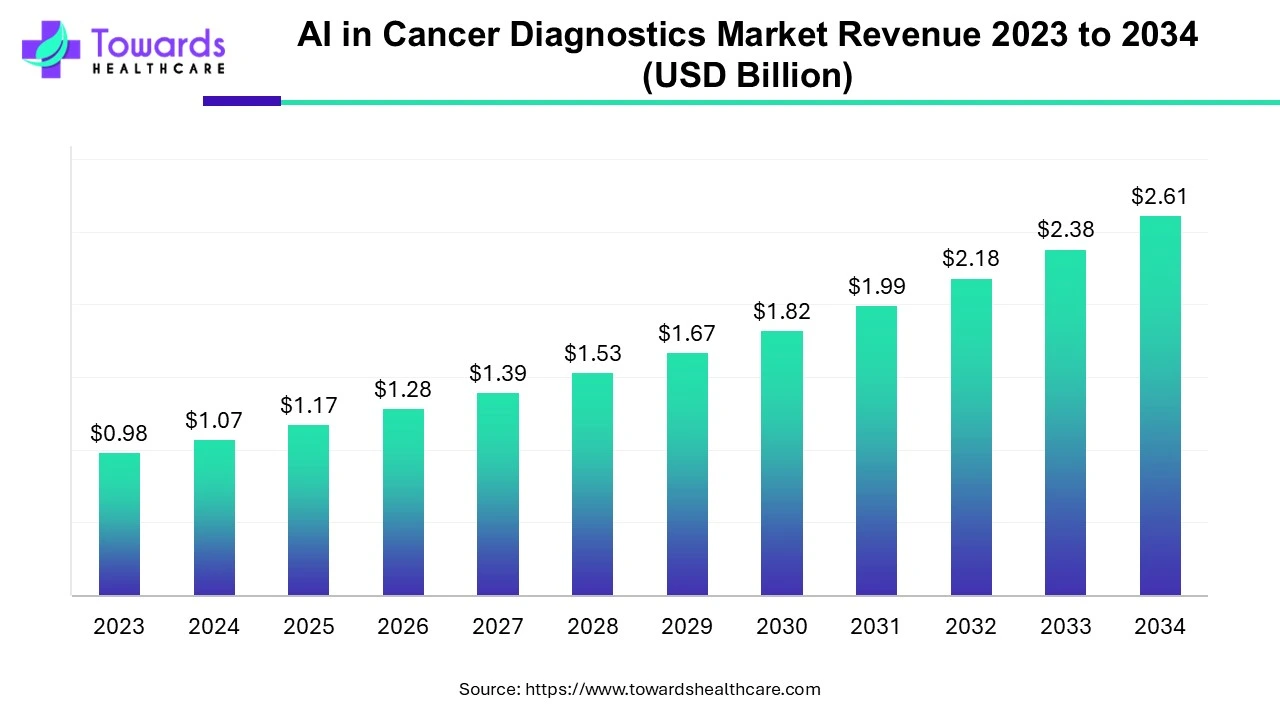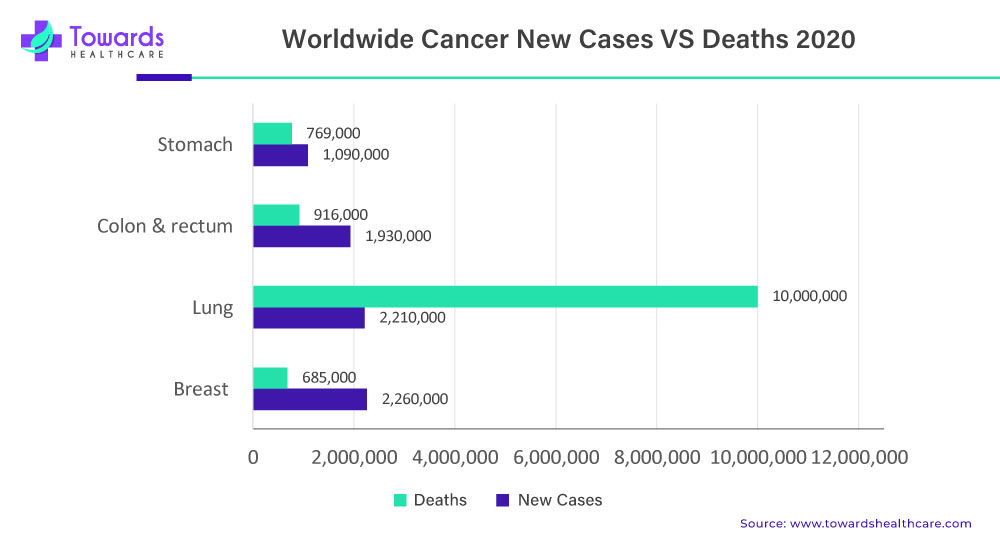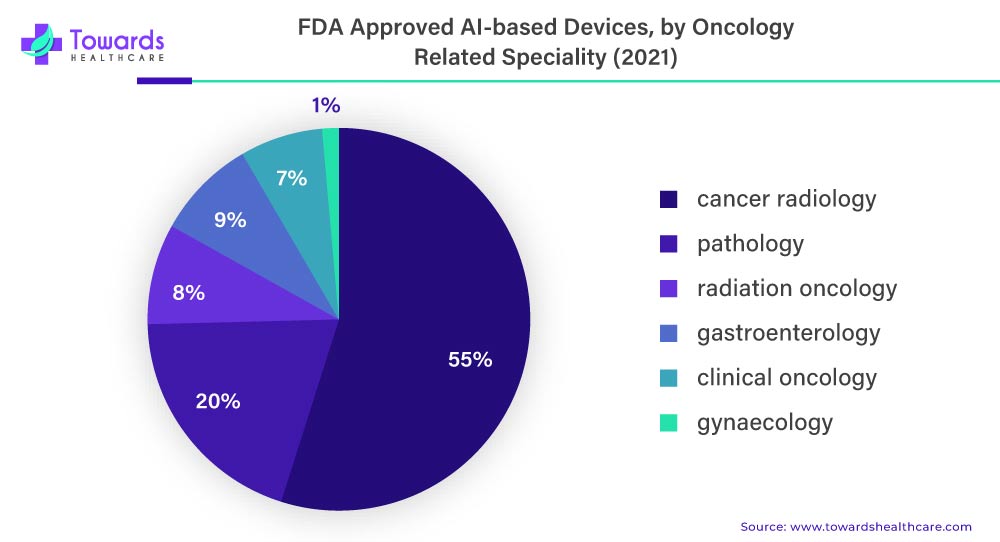December 2025

The global AI in cancer diagnostics market size is calculated at USD 1.07 billion in 2024 and is expected to be worth USD 2.61 billion by 2034, expanding at a CAGR of 9.35% from 2024 to 2034.

FDA published an updated list of around 178 new AI-based devices in July 2022 making it 500+ AI-based devices, out of which more than 75% are used in radiology.
Artificial intelligence (AI) is transforming the healthcare industry, particularly in cancer diagnostics, where it is being used to improve the speed, accuracy, and efficiency of cancer diagnosis. The AI in cancer diagnostics market is rapidly growing due to the rising prevalence of cancer worldwide, increasing demand for precision medicine, and advancements in machine learning algorithms and big data analytics. This article provides precise and analytical data on the current state and future trends of the AI in cancer diagnostics market.
AI in cancer diagnostics has applications in various areas, including medical imaging, genomics, and liquid biopsy. Among these, medical imaging is the largest application segment due to the wide availability of imaging data, advancements in image recognition algorithms, and the rising use of imaging in cancer diagnosis. In terms of AI technologies, machine learning is the most widely used technology for cancer diagnostics, accounting for the largest market share. Machine learning algorithms can analyze large datasets and identify patterns that are not visible to the human eye, thus improving the accuracy and efficiency of cancer diagnosis.
AI is transforming the field of cancer diagnostics, improving the accuracy, speed, and efficiency of cancer diagnosis. The AI in the cancer diagnostics market is rapidly growing, driven by various factors such as the rising prevalence of cancer, increasing demand for precision medicine, and advancements in AI technologies.
The global AI in the cancer diagnostics market is expected to witness significant growth in the coming years, driven by several key factors. One of the major drivers of this market is the increasing prevalence of cancer across the world. For instance, according to the World Health Organization (WHO), cancer is the leading cause of death globally and was responsible for around 10 million deaths in 2020. The rising incidence of cancer, coupled with the growing demand for early detection and diagnosis, has led to the adoption of AI-based diagnostic tools and techniques.
Cancer remains one of the leading causes of death worldwide, with millions of people diagnosed each year. While early detection and treatment can greatly improve outcomes, many cancers go undetected until later stages, when treatment options may be limited. However, the emergence of artificial intelligence (AI) in cancer diagnostics is changing the game, offering new tools and methods for earlier detection, more accurate diagnosis, and personalized treatment plans.

One of the major drivers behind the rise of AI in cancer diagnostics is the increasing availability of data. As more healthcare organizations digitize patient records, imaging data, and other clinical data, there is a wealth of information available that can be analyzed and used to improve cancer diagnosis and treatment. AI algorithms can analyze large volumes of data quickly and accurately, identifying patterns and trends that may not be immediately apparent to human clinicians.
AI in cancer diagnostics is being used in a variety of ways, from analyzing medical images to identifying genetic markers associated with certain cancers. For example, AI algorithms can analyze mammograms to detect breast cancer at an earlier stage than traditional methods, increasing the chances of successful treatment. In addition, AI is being used to develop new cancer biomarkers, which can be used to predict the likelihood of cancer recurrence and help clinicians develop personalized treatment plans.
Another key benefit of AI in cancer diagnostics is the ability to improve the accuracy of cancer diagnoses. Many cancers have similar symptoms or may appear similar on medical images, making it difficult for clinicians to accurately diagnose the type and stage of cancer. AI algorithms can analyze medical images and other data to identify subtle differences that may indicate a particular type of cancer, allowing for more accurate and timely diagnosis.
The rise of AI in cancer diagnostics has the potential to revolutionize the way cancer is diagnosed and treated. By improving early detection, increasing diagnostic accuracy, and enabling personalized treatment plans, AI is helping to improve outcomes for cancer patients around the world. As more healthcare organizations and technology companies invest in AI for cancer diagnostics, we can expect to see continued progress and innovation in this field.
The field of cancer diagnostics is being transformed by the integration of artificial intelligence (AI) technology. AI-powered cancer diagnostics have the potential to improve the detection, diagnosis, and treatment of cancer, which could have a significant impact on patient outcomes. Advancements in healthcare technology are also driving the adoption of AI in cancer diagnostics. The increasing availability of medical imaging data, such as CT scans, MRI scans, and X-rays, provides a rich source of information that can be analyzed by AI algorithms. This data can help to identify subtle patterns and abnormalities that may not be visible to the human eye, leading to more accurate and reliable cancer diagnoses. In January 2023, Paige and Microsoft's collaborated in the field of AI-enabled cancer diagnostics aiming to leverage the power of machine learning to analyze digital pathology images and develop new clinical applications and computational biomarkers for cancer diagnosis and treatment.
Medical imaging technologies have revolutionized the way we diagnose and treat cancer, enabling doctors to detect tumors and track disease progression with greater precision. However, the interpretation of these images is often complex and time-consuming, requiring skilled radiologists to analyze multiple images and identify potential cancerous lesions. This is where AI comes in - by utilizing machine learning algorithms and deep learning techniques, AI systems can analyze medical images more quickly and accurately, improving the speed and accuracy of cancer diagnoses.

In addition, rising partnerships among market players for the development of advanced solutions expand the growth of this market.
In addition to medical imaging, AI is also being used to analyze other types of data in cancer diagnostics, such as genomic data and patient medical records. By analyzing large datasets of genomic information, AI algorithms can identify genetic mutations that may increase the risk of developing certain types of cancer. Similarly, by analyzing patient medical records, AI systems can identify risk factors and patterns that may be indicative of cancer, helping doctors to make earlier and more accurate diagnoses. The use of AI in cancer diagnostics has the potential to improve patient outcomes by enabling earlier and more accurate diagnoses, leading to more effective treatment and better overall survival rates. As healthcare technology continues to advance, we can expect to see even more applications of AI in cancer diagnostics and treatment in the future.
One of the key challenges in AI-enabled cancer diagnostics is the availability of high-quality data. AI algorithms rely on large datasets to learn patterns and make accurate predictions, but in the field of cancer diagnostics, there is often a lack of standardized, comprehensive, and diverse data. This can hinder the development and implementation of AI-powered diagnostic tools. The lack of standardized, comprehensive, and diverse data is a major restraint for AI-enabled cancer diagnostics. Without access to sufficient and diverse data, AI algorithms may not be able to identify subtle patterns or accurately predict outcomes. This can lead to inaccurate diagnoses and treatment recommendations, which can ultimately harm patients. Additionally, data privacy concerns can limit the availability of data for AI-powered diagnostic tools, as healthcare organizations may be reluctant to share sensitive patient information.
To address this challenge, efforts are being made to bridge the gap between data availability and AI-powered cancer diagnostics. One approach is to establish partnerships between healthcare providers and technology companies to develop and implement data-sharing platforms. These platforms allow for the pooling of data from multiple sources, including electronic health records, imaging data, genomics data, and pathology data. By creating large and diverse datasets, AI algorithms can learn from a wider range of cancer cases, leading to more accurate and personalized diagnostics.
Another approach is to develop standardized data collection and sharing protocols. The use of standardized protocols can improve the quality and consistency of data, making it easier to analyze and compare across different datasets. This can also enable the creation of larger datasets, which can improve the accuracy of AI algorithms. Standardized protocols can also facilitate data sharing across different institutions and countries, leading to more comprehensive and diverse datasets.
In addition to these efforts, advances in technology are also improving the availability and quality of data for AI-enabled cancer diagnostics. For example, the increasing use of digital pathology, which allows for the digitization of pathology slides, is generating large amounts of data that can be used to train AI algorithms. Similarly, the development of new imaging techniques, such as high-resolution MRI and PET-CT scans, is also generating more detailed and informative data that can be used to develop AI-powered diagnostic tools.
Bridging the gap between data availability and AI-powered cancer diagnostics is critical for improving cancer diagnosis and treatment. By pooling data from multiple sources, developing standardized protocols, and leveraging advances in technology, we can create larger, more diverse, and higher-quality datasets that can be used to train AI algorithms and improve cancer diagnostics.
A cancer diagnosis has long been a laborious and time-consuming process, but with the advent of AI in cancer diagnostics, the future looks brighter. AI-powered diagnostic tools can analyze large amounts of data in a matter of seconds, allowing for faster and more accurate diagnoses, ultimately leading to improved patient outcomes. This presents a significant opportunity in the healthcare industry.
Moreover, the global AI in cancer diagnostics market is expected to grow rapidly in the coming years, providing an opportunity for businesses to capitalize on this trend. The rise in cancer prevalence worldwide is one of the primary drivers of market growth. Additionally, the increasing demand for personalized medicine and the adoption of AI-powered diagnostic tools by healthcare providers are contributing to the market's growth. AI-powered cancer diagnostics can improve the accuracy and speed of cancer diagnosis, enabling early detection and timely treatment. Traditional cancer diagnostic methods involve a manual review of medical imaging and pathology samples by trained medical professionals, which can be time-consuming and prone to human error. AI algorithms, on the other hand, can rapidly analyze large amounts of data, identify subtle patterns and anomalies, and provide accurate and consistent results.
This has the potential to revolutionize cancer diagnosis by providing faster and more accurate diagnoses, which can lead to earlier intervention and better treatment outcomes. Additionally, AI-powered cancer diagnostics can reduce the workload of healthcare professionals, freeing up their time to focus on patient care.
By component, the software solutions segment led the market and is expected to grow at the fastest rate in the market during the forecast period. Software solutions leverage AI, deep learning, and convolutional neural networks (CNNs), which can quickly analyze and diagnose different types of tumors. The demand is due to ease of use and availability of software solutions developed by major players. Software solutions can also guide treatment choice and predict survival and chances of recurrence in patients.
By cancer type, the lung cancer segment dominated the market in 2024. This is due to the rising prevalence of lung cancer and its severity. Lung cancer is the most common form of cancer among adults globally. Smoking, air pollution, and hereditary factors are some of the common risk factors of lung cancer. The WHO estimates 2.5 million new lung cancer cases annually, accounting for 12.4% of all cases.
By cancer type, the brain tumor segment is projected to expand rapidly in the market in the coming years. The increasing incidences of brain tumor cases and the complexity of the disease increase the need for AI in diagnosing brain tumors.
By end-user, the hospital segment registered its dominance over the global. The increasing number of patients, favorable infrastructure, sufficient capital investments, and the presence of trained professionals drive the market.
By end-user, the surgical centers & medical institutes segment is anticipated to grow with the highest CAGR in the market during the studied years. The increasing number of surgical centers and technological advancements in medical institutes potentiate market growth.
North America dominated the AI in cancer diagnostics market in 2023. The rising incidences of cancer, technological advancements, and the presence of key players drive the market. According to the American Cancer Society, approximately 2 million new cancer cases were reported in the U.S. in 2022. At the same time, around 0.23 million people were diagnosed with cancer in Canada in 2022. The market is also driven by favorable government policies and regulatory approvals. The US Food and Drug Administration has approved AI-assisted tools to help detect cancers of the brain, breast, lung, prostate, skin, and thyroid.
Asia-Pacific is projected to host the fastest-growing AI in cancer diagnostics market in the coming years. The rapidly growing population, increasing incidences of cancer, increasing investments & collaborations, and favorable government policies drive the market. The Chinese government actively supports the use of AI in the healthcare sector. It is targeting a 7% annual growth in R&D expenditure, giving a particular emphasis on AI, as part of its latest Five-Year Plan (2021-2025). McKinsey predicted an economic contribution of around $5 billion. Similarly, the Indian government’s initiative “Ayushman Bharat Digital Mission” supports the use of AI models offering a digitized health ecosystem.
Japan Market Trends
It is estimated that the incidence of cancer in Japan was approximately 979,300 in 2024, along with about 393,100 cancer-related deaths. Cancer imposes a significant economic burden on the Japanese healthcare sector. The estimated cost of cancer is estimated to be more than 1,024,006 million Japanese yen.
India Market Trends
India has a lower detection rate of 29% for all cancer types, including 15% for breast cancer and 33% for lung cancer. This highlights the significance of AI tools for early detection of cancer. Numerous clinics and diagnostics in India adopt advanced technologies for diagnosing and treating cancer. The Indian government has introduced robust policies, strategic interventions, and financial assistance schemes.
Europe is estimated to host a significantly growing AI in the cancer diagnostics market during the forecast period. Europe is experiencing a rise in the adoption of technological advancements. Furthermore, the increasing research, which is supported by the government as well as regulatory bodies, is also driving the market growth.
UK Market Trends
The healthcare sector in the UK is advancing as it is utilizing various technological advancements. At the same time, the industries are also using it to develop new diagnostic approaches for cancer. This is further supported by the investment provided by the government.
Germany Market Trends
Germany is driven by the rising research in the industries as well as the institutes in cancer diagnosis using AI technologies. This increases the collaborations between the companies. Furthermore, the regulations of the regulatory bodies help to enhance the safety and privacy of the patients. This, in turn, enhances patient satisfaction and outcomes.
Roche Diagnostics discovers new medicines, diagnostics, and digital health solutions to improve health outcomes. The company generated total sales of CHF 60.5 billion in 2024, an increase of 7% from 2023. In 2024, the company launched 21 diagnostic tests, 5 diagnostic platforms, and 7 digital solutions.
GE Healthcare is a leading global medical technology and digital solutions innovator. It offers AI-powered imaging and advanced therapies for oncology diagnosis. The second quarter 2025 revenue was $5 billion, an increase of 3%. The growth was driven by strength in the U.S., Europe, and the MENA region.
Kalyan Sivasailam, Co-founder and CEO of 5C Network Pvt. Ltd. commented that integrating AI technologies into cancer diagnostics holds immense potential for improving diagnostic accuracy, personalizing treatment plans, and ultimately enhancing patient outcomes. He also warned to consider the ethical, regulatory, and practical challenges to ensure safe and effective deployment in clinical settings.
By Component
By Cancer Type
By End-User
By Region
December 2025
December 2025
December 2025
December 2025